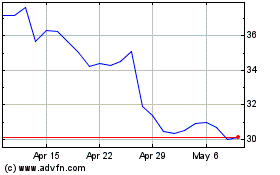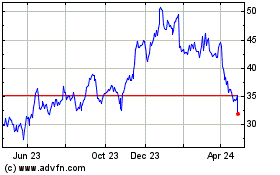Intel CEO Details Priorities Beyond PCs
April 26 2016 - 4:03PM
Dow Jones News
By Don Clark
Intel Corp. Chief Executive Brian Krzanich provided further
details on how the company hopes to generate more revenue growth,
describing five priorities for the chip maker as it reduces its
dependence on the shrinking personal computer market.
Mr. Krzanich, in a blog post Tuesday following a major
restructuring announced last week, stated that cloud computing is
the most important trend that will shape the company's future.
Intel, which already dominates sales of chips used in the data
centers that deliver cloud services, will focus increasingly on
technologies for analyzing data to help reinforce and expand its
position, he said.
The company's strong position in data centers is a linchpin for
much of the other efforts, Mr. Krzanich wrote. For example, in
addressing another priority known as the Internet of Things --
Silicon Valley shorthand for adding calculating and communications
capability to just about everything that is not a computer --
Intel's market position will be tied primarily to its ability to
process the data generated by products such as connected
lightbulbs, doorlocks and office and factory equipment.
"The key phrase here is 'connected to the cloud,'" Mr. Krzanich
wrote. "It means that everything that a 'thing' does can be
captured as a piece of data, measured real-time, and is accessible
from anywhere."
Intel tends to focus on processors more complex and expensive
than can be practically added to many products purchased for homes
and businesses. Mr. Krzanich said the company plans to mainly focus
on putting chips into autonomous vehicles and industrial and retail
hardware, while characterizing PCs and mobile devices as "among the
many variations of connected things."
Mr. Krzanich said Intel will continue to place a top priority on
pushing Moore's Law, the pattern of miniaturization of chip
circuitry identified by co-founder Gordon Moore in the 1960s that
has governed Silicon Valley innovation. The company last year
stated that it now expects to reduce transistor dimensions by the
customary 50% about every 2 1/2 years, rather than two.
He has expressed confidence recently that the company can
eventually get back on a two-year cadence, but he didn't specify a
time frame in the blog post.
Another priority identified by Mr. Krzanich is memory chips,
particularly variations of the flash technology found in most
mobile devices. Intel is upgrading a factory in China to make those
chips. It also announced a new technology in the field called 3D
XPoint that was developed with help from Micron Technology Inc.
The fifth focus laid out in the blog post is connectivity in the
form of wireless communications. Intel has largely failed to gain
much of a foothold in chips for fourth-generation LTE networks. Mr.
Krzanich vowed the company will play a major role in the transition
to 5G technology, "from modems to base stations to all the various
forms of connectivity that exist today and will exist
tomorrow."
Intel last November recruited Venkata "Murthy" Renduchintala, a
former executive vice president at rival Qualcomm Inc., to a top
position that oversees both PC and mobile. Aicha Evans, a vice
president in charge of wireless chips who had recently submitted
her resignation, has now decided to stay with the company,
according to a person familiar with the situation.
Mr. Krzanich's blog post follows the announcement last week that
it will cut 12,000 jobs, or 11% from its workforce, to reduce costs
and help free up money to invest in new areas. In documents filed
with state officials, Intel this week disclosed that 784 employees
will be laid off in Oregon, 565 in California and 560 in
Arizona.
Write to Don Clark at don.clark@wsj.com
(END) Dow Jones Newswires
April 26, 2016 15:48 ET (19:48 GMT)
Copyright (c) 2016 Dow Jones & Company, Inc.
Intel (NASDAQ:INTC)
Historical Stock Chart
From Mar 2024 to Apr 2024

Intel (NASDAQ:INTC)
Historical Stock Chart
From Apr 2023 to Apr 2024
